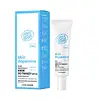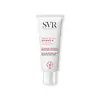What's inside
What's inside
 Key Ingredients
Key Ingredients

 Benefits
Benefits

 Concerns
Concerns

 Ingredients Side-by-side
Ingredients Side-by-side

Water
Skin ConditioningDibutyl Adipate
EmollientDiethylamino Hydroxybenzoyl Hexyl Benzoate
UV FilterC12-15 Alkyl Benzoate
AntimicrobialPropanediol
SolventGlycerin
HumectantCetearyl Olivate
Tris-Biphenyl Triazine
UV AbsorberBehenyl Alcohol
EmollientGlyceryl Stearate
EmollientSorbitan Olivate
EmulsifyingCaprylic/Capric Triglyceride
MaskingIsoamyl Laurate
EmollientEthylhexyl Triazone
UV AbsorberBis-Ethylhexyloxyphenol Methoxyphenyl Triazine
Skin ConditioningMethylene Bis-Benzotriazolyl Tetramethylbutylphenol
UV FilterOrbignya Oleifera Seed Oil
EmollientSimmondsia Chinensis Seed Oil
EmollientSodium Hyaluronate Crosspolymer
HumectantSodium Hyaluronate
HumectantHyaluronic Acid
HumectantAloe Barbadensis Leaf Juice Powder
Skin ConditioningPanthenol
Skin ConditioningPolyglyceryl-3 PCA
EmollientEthylhexyl Stearate
EmollientGlycine Soja Oil
EmollientArachidyl Glucoside
EmulsifyingArachidyl Alcohol
EmollientTocopherol
AntioxidantBeta-Sitosterol
Emulsion StabilisingAscorbyl Palmitate
AntioxidantMicrocrystalline Cellulose
AbsorbentXanthan Gum
EmulsifyingCellulose Gum
Emulsion StabilisingDecyl Glucoside
CleansingPolyglyceryl-4 Diisostearate/Polyhydroxystearate/Sebacate
EmulsifyingSodium Isostearate
CleansingSqualene
EmollientPropylene Glycol
HumectantButylene Glycol
HumectantDisodium Phosphate
BufferingRaspberry Ketone
MaskingBenzyl Alcohol
PerfumingParfum
MaskingHexyl Cinnamal
PerfumingCitronellol
PerfumingLinalool
PerfumingLimonene
PerfumingWater, Dibutyl Adipate, Diethylamino Hydroxybenzoyl Hexyl Benzoate, C12-15 Alkyl Benzoate, Propanediol, Glycerin, Cetearyl Olivate, Tris-Biphenyl Triazine, Behenyl Alcohol, Glyceryl Stearate, Sorbitan Olivate, Caprylic/Capric Triglyceride, Isoamyl Laurate, Ethylhexyl Triazone, Bis-Ethylhexyloxyphenol Methoxyphenyl Triazine, Methylene Bis-Benzotriazolyl Tetramethylbutylphenol, Orbignya Oleifera Seed Oil, Simmondsia Chinensis Seed Oil, Sodium Hyaluronate Crosspolymer, Sodium Hyaluronate, Hyaluronic Acid, Aloe Barbadensis Leaf Juice Powder, Panthenol, Polyglyceryl-3 PCA, Ethylhexyl Stearate, Glycine Soja Oil, Arachidyl Glucoside, Arachidyl Alcohol, Tocopherol, Beta-Sitosterol, Ascorbyl Palmitate, Microcrystalline Cellulose, Xanthan Gum, Cellulose Gum, Decyl Glucoside, Polyglyceryl-4 Diisostearate/Polyhydroxystearate/Sebacate, Sodium Isostearate, Squalene, Propylene Glycol, Butylene Glycol, Disodium Phosphate, Raspberry Ketone, Benzyl Alcohol, Parfum, Hexyl Cinnamal, Citronellol, Linalool, Limonene
Water
Skin ConditioningDicaprylyl Carbonate
EmollientDiethylamino Hydroxybenzoyl Hexyl Benzoate
UV FilterDiethylhexyl Butamido Triazone
UV AbsorberDiisopropyl Adipate
EmollientSilica
AbrasiveCetearyl Alcohol
EmollientBis-Ethylhexyloxyphenol Methoxyphenyl Triazine
Skin ConditioningCeteareth-20
CleansingEthylhexyl Triazone
UV AbsorberDimethicone
EmollientNiacinamide
SmoothingPolymethyl Methacrylate
Pentylene Glycol
Skin ConditioningPolyester-7
Skin ConditioningAminomethyl Propanol
BufferingBeta-Carotene
Skin ConditioningBeta-Sitosterol
Emulsion StabilisingCetearyl Dimethicone Crosspolymer
Daucus Carota Sativa Root Extract
Skin ConditioningGlycine Soja Oil
EmollientHydrogenated Phosphatidylcholine
EmulsifyingLecithin
EmollientLepidium Sativum Sprout Extract
Skin ConditioningSqualene
EmollientAlpha-Glucan Oligosaccharide
CleansingCaffeyl Glucoside
AntioxidantDisodium Acetyl Glucosamine Phosphate
Skin ConditioningGlucose
HumectantGlycerin
HumectantPhytic Acid
Rhamnose
HumectantTocopherol
AntioxidantTocopheryl Acetate
Antioxidant1,2-Hexanediol
Skin ConditioningCaprylic/Capric Triglyceride
MaskingCaprylyl Glycol
EmollientCitric Acid
BufferingGlucuronic Acid
BufferingHydroxyethyl Acrylate/Sodium Acryloyldimethyl Taurate Copolymer
Emulsion StabilisingLysolecithin
EmulsifyingNeopentyl Glycol Diheptanoate
EmollientPolysorbate 60
EmulsifyingPropanediol
SolventSodium Laureth Sulfate
CleansingSorbitan Isostearate
EmulsifyingXanthan Gum
EmulsifyingPotassium Sorbate
PreservativeSodium Benzoate
MaskingWater, Dicaprylyl Carbonate, Diethylamino Hydroxybenzoyl Hexyl Benzoate, Diethylhexyl Butamido Triazone, Diisopropyl Adipate, Silica, Cetearyl Alcohol, Bis-Ethylhexyloxyphenol Methoxyphenyl Triazine, Ceteareth-20, Ethylhexyl Triazone, Dimethicone, Niacinamide, Polymethyl Methacrylate, Pentylene Glycol, Polyester-7, Aminomethyl Propanol, Beta-Carotene, Beta-Sitosterol, Cetearyl Dimethicone Crosspolymer, Daucus Carota Sativa Root Extract, Glycine Soja Oil, Hydrogenated Phosphatidylcholine, Lecithin, Lepidium Sativum Sprout Extract, Squalene, Alpha-Glucan Oligosaccharide, Caffeyl Glucoside, Disodium Acetyl Glucosamine Phosphate, Glucose, Glycerin, Phytic Acid, Rhamnose, Tocopherol, Tocopheryl Acetate, 1,2-Hexanediol, Caprylic/Capric Triglyceride, Caprylyl Glycol, Citric Acid, Glucuronic Acid, Hydroxyethyl Acrylate/Sodium Acryloyldimethyl Taurate Copolymer, Lysolecithin, Neopentyl Glycol Diheptanoate, Polysorbate 60, Propanediol, Sodium Laureth Sulfate, Sorbitan Isostearate, Xanthan Gum, Potassium Sorbate, Sodium Benzoate
Ingredients Explained
These ingredients are found in both products.
Ingredients higher up in an ingredient list are typically present in a larger amount.
Beta-Sitosterol is a plant-derived fatty acid with a structure similar to cholesterol (which naturally occurs in skin). It helps hydrate the skin and stabilize formulations.
This ingredient can be naturally found in fruits, veggies, nuts, and seeds.
You might know this ingredient as Tinosorb S or Bemotrizinol. It is a UV filter that covers both UVA and UVB rays.
This ingredient has two peak UV absorption peaks ( 310 and 340 nm) and is able to absorb both UV-A and UV-B rays. This ingredient works by preventing UV rays from reaching and damaging your skin.
On top of that - it is highly photostable and helps prevent the photodegration of other sunscreen ingredients such as avobenzone.
Tinosorb S is allowed in the EU, Australia, and Asia. It is close to being approved by the FDA and we'll hopefully get this ingredient in the U.S. by late 2025.
Fun fact: Tinosorb S is the most effective UV absorber at maximum concentration (measured by SPF) permitted in the EU.
This ingredient is oil-soluble, so your oil-cleansers will take this right off at night.
Learn more about Bis-Ethylhexyloxyphenol Methoxyphenyl TriazineThis ingredient is an emollient, solvent, and texture enhancer. It is considered a skin-softener by helping the skin prevent moisture loss.
It helps thicken a product's formula and makes it easier to spread by dissolving clumping compounds.
Caprylic Triglyceride is made by combining glycerin with coconut oil, forming a clear liquid.
While there is an assumption Caprylic Triglyceride can clog pores due to it being derived from coconut oil, there is no research supporting this.
Learn more about Caprylic/Capric TriglycerideDiethylamino Hydroxybenzoyl Hexyl Benzoate (DHHB) is a chemical UV-A absorber. It is formulated for high UVA protection (320-400 nm).
DHHB is well-liked for:
DHHB has been approved by the EU, Japan, Taiwan, and South America for use up to 10%. Unfortunately, it has not been approved for use in the US or Canada due to slow regulatory processes.
This ingredient is soluble in oils, fats, and lipids.
Learn more about Diethylamino Hydroxybenzoyl Hexyl BenzoateEthylhexyl Triazone is a modern chemical sunscreen that protects from UV-B radiation.
It is the most effective of existing UV-B filters, as it provides the highest level of photo-stable absorption. It protects from the entire UV-B range (280 to 320nm), with it's highest level of protection at 314nm.
Ethylhexyl Triazone is oil soluble, oderless and colorless, which mean it is able to be incorporated into a variety of different formulations.
It is not currently available within the United States due to slow changing FDA regulations. Outside of the US, it is used in formulations at concentrations up to 5%.
Learn more about Ethylhexyl TriazoneGlycerin is already naturally found in your skin. It helps moisturize and protect your skin.
A study from 2016 found glycerin to be more effective as a humectant than AHAs and hyaluronic acid.
As a humectant, it helps the skin stay hydrated by pulling moisture to your skin. The low molecular weight of glycerin allows it to pull moisture into the deeper layers of your skin.
Hydrated skin improves your skin barrier; Your skin barrier helps protect against irritants and bacteria.
Glycerin has also been found to have antimicrobial and antiviral properties. Due to these properties, glycerin is often used in wound and burn treatments.
In cosmetics, glycerin is usually derived from plants such as soybean or palm. However, it can also be sourced from animals, such as tallow or animal fat.
This ingredient is organic, colorless, odorless, and non-toxic.
Glycerin is the name for this ingredient in American English. British English uses Glycerol/Glycerine.
Learn more about GlycerinGlycine Soja Oil comes from the soybean. Glycine Soja is native to eastern Asia.
Soybean oil is an emollient. It is rich in antioxidants and fatty acids including palmitic, stearic, oleic, and linoleic acids.
As an emollient, the fatty acids in soybean oil helps keep your skin soft and hydrated. It does so by creating a film on top that traps moisture in.
Soybean oil is also rich in vitamin E, a potent antioxidant. Vitamin E is also anti-inflammatory and provides a soothing effect.
Studies show soy may help fade hyperpigmentation from UVB. It does so by disrupting the melanin process from UVB induced skin inflammation.
This ingredient may not be malassezia folliculitis, or fungal-acne, safe.
Soybeans are rich in proteins and are part of the legume family. Foods made with soybeans include tofu, soymilk, edamame, miso, and soy sauce.
Learn more about Glycine Soja OilPropanediol is an all-star ingredient. It softens, hydrates, and smooths the skin.
It’s often used to:
Propanediol is not likely to cause sensitivity and considered safe to use. It is derived from corn or petroleum with a clear color and no scent.
Learn more about PropanediolSqualene is naturally found in plants and animals, including our skin and sebum. It is a lipid our bodies naturally produce and makes up about 10-12% of the oil on our skin. Our skin produces squalene to keep itself naturally hydrated.
This ingredient is a potent antioxidant and can help fight against skin damage.
Sources of squalene include olives and rice bran. Some sources may be animals such as from shark liver.
Squalane comes from squalene and is created using hydrogenation. Squalane is lighter than squalene.
Hydrogenation is the conversion from unsaturated oil to saturated oil. This makes squalane more stable and have a longer shelf life than squalene.
Read more about squalane with an "a".
Learn more about SqualeneTocopherol (also known as Vitamin E) is a common antioxidant used to help protect the skin from free-radicals and strengthen the skin barrier. It's also fat soluble - this means our skin is great at absorbing it.
Vitamin E also helps keep your natural skin lipids healthy. Your lipid skin barrier naturally consists of lipids, ceramides, and fatty acids. Vitamin E offers extra protection for your skin’s lipid barrier, keeping your skin healthy and nourished.
Another benefit is a bit of UV protection. Vitamin E helps reduce the damage caused by UVB rays. (It should not replace your sunscreen). Combining it with Vitamin C can decrease sunburned cells and hyperpigmentation after UV exposure.
You might have noticed Vitamin E + C often paired together. This is because it is great at stabilizing Vitamin C. Using the two together helps increase the effectiveness of both ingredients.
There are often claims that Vitamin E can reduce/prevent scarring, but these claims haven't been confirmed by scientific research.
Learn more about TocopherolWater. It's the most common cosmetic ingredient of all. You'll usually see it at the top of ingredient lists, meaning that it makes up the largest part of the product.
So why is it so popular? Water most often acts as a solvent - this means that it helps dissolve other ingredients into the formulation.
You'll also recognize water as that liquid we all need to stay alive. If you see this, drink a glass of water. Stay hydrated!
Learn more about WaterXanthan gum is used as a stabilizer and thickener within cosmetic products. It helps give products a sticky, thick feeling - preventing them from being too runny.
On the technical side of things, xanthan gum is a polysaccharide - a combination consisting of multiple sugar molecules bonded together.
Xanthan gum is a pretty common and great ingredient. It is a natural, non-toxic, non-irritating ingredient that is also commonly used in food products.
Learn more about Xanthan Gum